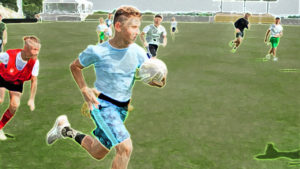General strength training is important for rugby, but general training will only take you so far. The very specific demands of rugby mean that, sometimes, you’ll need to step outside the confines of traditional strength training to fully prepare your body for rugby.
Here are EIGHT strength training methods you can use in the gym to make your strength training workouts more rugby specific. You’ll undoubtedly raise a few eyebrows with these methods but your rugby performance will soar as a result!
Use a towel for pulling exercises
It really doesn’t matter how strong you are; if you cannot apply that strength to the opposition, it’s all show and no go. The weak link for many players is grip.
Barbells and dumbbells are designed to be as easy to hold as possible. Their 1.2-inch diameter allows you to wrap your fingers tightly around the bar, and most also have roughened areas of knurling to further enhance grip. If only the opposition were so accommodating!
You can make virtually every pulling exercise more grip-specific by using a gym towel or two. Simply loop the towel around the bar, clamp both ends in your hands, and start pulling.
Good towel grip exercises include:
- Chin-ups/pull-ups
- Dumbbell rows
- Biceps curls
- Farmer’s walks
- Jefferson curls
Check out this short video to see towel grip chin-ups in action:
Fat bars and fat grips
Fat bar training makes both pulling and pushing exercises more demanding – especially for your grip. And, as you know, strong hands and a powerful grip are rugby essentials.
However, the benefits of fat bar training go beyond grip training. Because they make whatever you are lifting harder to handle, your muscles and joints are both on the receiving end of an increased training stimulus.
When faced with a thicker-than-average bar you’ll have to squeeze that bar extra hard, and that causes an irradiating effect up through your wrists, elbows, and shoulders. This helps develop greater intra-muscular coordination and enhanced joint stability. In a sport like rugby, where instability is common, this is a very beneficial training effect.
You can use a fat bar for most regular barbell exercises. No fat bar at your gym? Use fat grips which clip onto a regular barbell or dumbbells. Too cheap to buy fat grips? Wrap a towel around your bar instead.
Add mid-rep pauses
Most strength training exercises follow a very predictable series of movements; you lower the bar and then push it back up. You know exactly what to expect from one rep to the next. While that predictability means you are free to focus on performing your chosen exercise, it’s not how your muscles work during rugby.
In rugby, you don’t always get things your own way. In a scrum, for example, you might gain a yard, stagger to a halt, and then have to regain your forward momentum. You might even have to recover after being driven back a yard or two.
One way to train for this in the gym is to add mid-rep pauses to your main lifts. This breaks up your momentum, and teaches you how to restart a heavily loaded movement from a dead stop.
You can add a mid-rep pause to almost any exercise, but the most beneficial for rugby are the squat, bench press, deadlift, and bent-over row as these exercises arguably have the greatest carryover to the demands of the game.
Rules for effective pauses
- Stay tight during the pause – do not relax
- Lower the weight into the pause under control
- Explode out of the pause – try to maximize bar speed
- Reduce the weight initially – pauses make weights feel much heavier
- Lower reps – focus on quality rather than quantity
1. Paused squats: descend as normal but then, as you hit 90-degrees of knee flexion, hold your position for 2-3 seconds. Explode up, catch your breath, and repeat.
2. Paused bench press: lower the bar to lightly touch your chest. Without relaxing, hold the bar on your chest for 2-3 seconds, and then drive it up to finish your rep.
3. Paused deadlifts: break the bar away from the floor as normal, but then pause with it at around knee-height for 2-3 seconds. Stand up to complete your rep, lower the bar back to the floor, and repeat.
4. Paused bent-over rows: using a barbell, row the bar into your abdomen and then hold it there for 2-3 seconds. Keep your shoulders back, your core braced, and your lower back tightly arched. Lower the bar and repeat.
See how to do paused deadlifts in this video:
Cardio-strength supersets
While strength is crucial in rugby, you need to be able to apply that strength in a variety of situations. In the gym, the environment is ideal for developing and demonstrating strength; you’ll have a good rest between sets, have time to get psyched up before lifting, and can choose when you start your next set. The reality of the rugby pitch is very different.
In rugby, you have to be able to respond to the flow of play even when you are on the back foot, feeling tired, and have just picked yourself off the floor after a previous phase of play.
You can (and should) replicate this by periodically combining intense cardio intervals with strength training. Doing a short bout of intense cardio immediately before a strength exercise replicates those times where you have to sprint and then drive into a ruck or maul.
The cardio burst itself should be around 20-40 seconds, and be intense enough to get you huffing and puffing. Immediately transition to the strength exercise, even if you don’t feel quite ready. Remember; that’s kind of the point!
Try these cardio-strength supersets or invent your own.
- Kettlebell swings and bench presses
- Jump rope double-unders and deadlifts
- Shuttle sprint and squats
- Bike sprints and push-presses
- Burpees and pull-ups
Asymmetrical loads
Barbells are very well balanced. In fact, barbells are designed to make strength training as comfortable and effective as possible. The combination of revolving sleeves, knurled grips, and clearly marked spacing rings means that you should have no major balance issues when doing barbell exercises.
Rugby, in contrast, is rarely so predictable. Opposing players are not so well-balanced (!) and will often present a very unstable obstacle to overcome.
You can train for this rugby-specific problem by lifting odd objects, such as sandbags and water barrels, as well as doing drills that involve lifting and carrying your training partners or team mates.
However, if you train in a gym, that’s not always practical. That’s where asymmetrical load training comes in.
Instead of loading your bar with the same weight each side, or using equally-paired dumbbells, create in imbalance. Put between 2.5 to 5 percent more weight on one end of your barbell or, if using dumbbells, use an odd pair e.g. 12.5 kg and 15 kg. This WILL feel unusual, but that’s the idea.
Despite the asymmetrical load, you should strive to perform your reps as normal. In fact, to the casual observer, there should be no real sign that you are training with unbalanced weights. Make sure you swap sides set by set.
Unstable training
In rugby, you often have to produce force from an unstable position. To improve this (st)ability, you should include at least some unstable training in your workouts. Using odd-objects can be a particularly good way to achieve this.
In the fitness industry, unstable training typically involves doing your strength exercises on a stability ball or BOSU. While this might be an effective way to create instability, it will often limit the amount of weight you can safely lift.
A better way to do this is to modify your barbell exercise by hanging weights from the bar using resistance bands. This creates true instability while preserving the movements that you need to perform for better rugby performance.
Just attach a weight to a resistance band and then hang it on the end of your barbell. Do the same both ends. You will then find your chosen barbell becomes very unstable and incredibly demanding. You’ll not only feel this in the target muscles, but all of your stabilizers too. You can use this trick for almost any barbell exercise that does not involve placing the bar on the floor.
See this method applied to the bench press in this video:
Single limb exercises
Most strength exercises are bilateral i.e. they use two limbs at a time. In contrast, rugby often takes place one limb at a time, i.e. unilaterally. Make sure you include unilateral exercises in your workouts as well as bilateral. We’ve outlined several of these in our leg workout program. But some other good options include:
- Single-leg squats
- Lunges
- Bulgarian split squats
- Step-ups
- Single-leg Romanian deadlifts
- Single arm dumbbell bench press
- Single arm lat pull downs
- Single arm seated row
- Single arm shoulder press
Take your single arm overhead press training to a new level with the javelin press:
If you train hard, you need to recover hard too. Good recovery starts with our newest product Post-Rugby. Post-Rugby contains a proven formula designed to enhance protein synthesis and fuel your body after rugby games and training. Packed with BCAAs, creatine and electrolytes, optimize your recovery by taking Post-Rugby within 30 minutes of finishing your rugby game or gym session. You can find this as a stand-alone supplement, or also get it as part of several different stacks.


